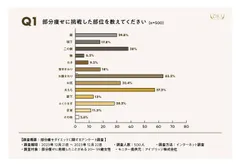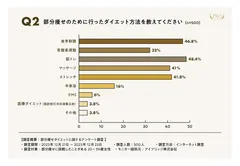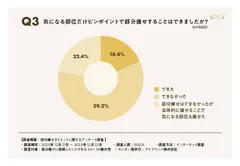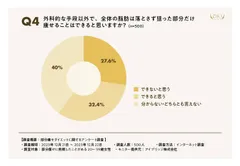Can't lose weight in parts? Dio Clinic has conducted a Survey on Partial Slimming Diet
ディオクリニック
Dio Clinic ( https://dioclinic.jp/ ), which specializes in providing companion medical diet services, conducted a survey from December 21, 2023 to December 22, 2023 on "dieting for partial weight loss".
The following is an overview of the survey, its results, and the views of Dr. Takahiro Fujii, General Director of Dio Clinic, on partial weight loss.
Survey Contents
Outline of the survey :Questionnaire survey on partial weight loss
Survey period : December 21, 2023 - December 22, 2023
Survey target : Women aged 20-59 who have tried to lose weight in parts of their bodies
Number of persons surveyed :500
Survey method Internet survey
Monitor provider : I-Bridge Corporation
Summary of survey results
The most common target area of concern was the "abdominal area" and other areas where fat tends to accumulate or is noticeable in general.
In general, diet restriction is the most common method, but for the purpose of partial slimming, many respondents used "muscle training," "massage," "stretching," and other dieting methods that can target specific areas.
Only 18.4% of respondents were able to lose weight in a specific area of concern.
Although most of the respondents could not lose weight in one part of their body, 27.6% of them still think that it is impossible to lose weight in one part of their body after completing the diet, a contradictory result.
The most common area where partial weight loss was attempted was "around the belly," and areas where fat tends to accumulate or is noticeable were at the top of the list.
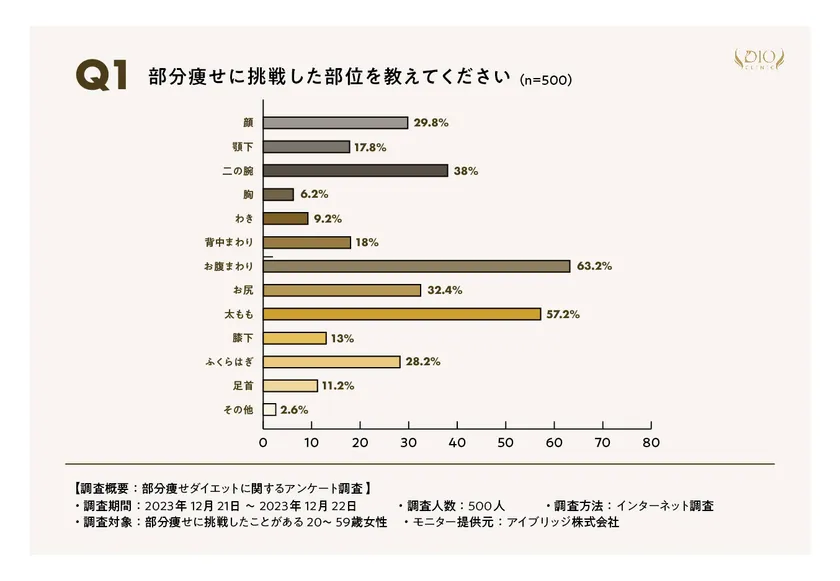
Partial Slimming Questionnaire 01
When asked about areas where they have tried to lose weight, the most common answer was "around the belly" (63.2%), followed closely by "thighs" (57.2%).
This was followed by "arms (38%)," "buttocks (32.4%)," and "face (29.8%)," indicating that many people are concerned about areas where fat tends to accumulate or where fat tends to make the body look out of shape or fatten them up.
For the purpose of partial weight loss, many respondents tend to use dieting methods that target specific areas of the body.
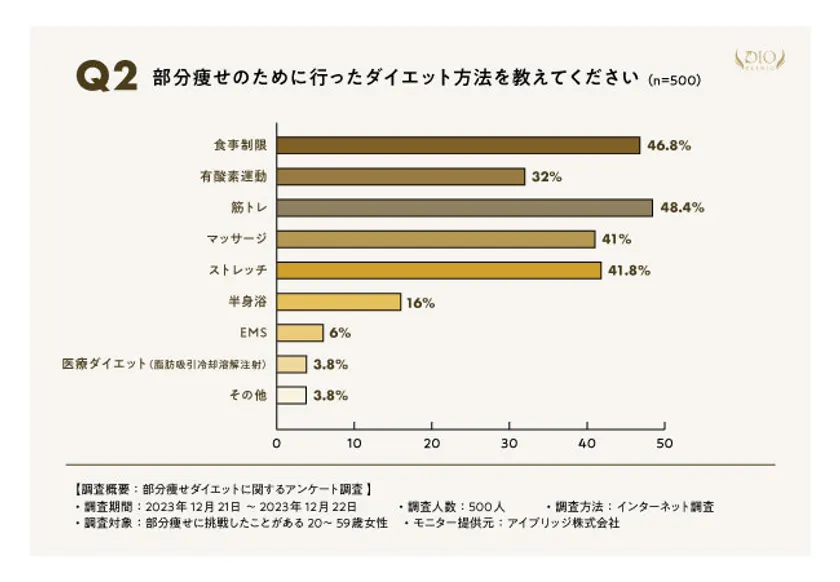
Partial Slimming Questionnaire 02
In terms of the methods used to lose weight, muscle training (48.4%) was the most popular, followed by stretching (41.8%), massage (41%), and other methods that provide pinpoint stimulation by moving and stretching the area of concern.
Since diet restriction and aerobic exercise tend to be favored in general dieting, this may be considered a trend specific to dieting for the purpose of partial body slimming.
Only 18.4% of respondents succeeded in losing weight in one part of their body.
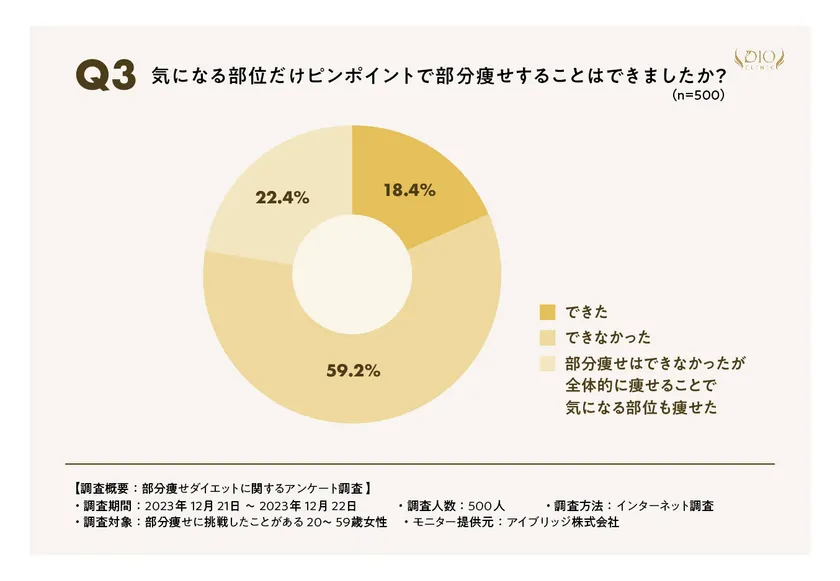
Questionnaire 03: Partial weight loss
When asked whether they were actually able to lose weight in certain areas, the overwhelming majority said they were not able to (59.2%), while the opposite was true for those who were able to (18.4%), a very low success rate.
Many respondents attempted to lose weight by muscle training, massaging, and stretching, but it seems that it may be difficult to lose weight partially by these methods.
More respondents who said they "could not lose weight in one part of their body but could lose weight in the area of concern by losing weight overall (22.4%)" than those who succeeded in losing weight in one part of their body, suggesting that a total body diet may result in the loss of fat in the area of concern rather than partial weight loss.
▼ Q4: Despite the failure, a large percentage of respondents continue to believe that "partial weight loss is possible.
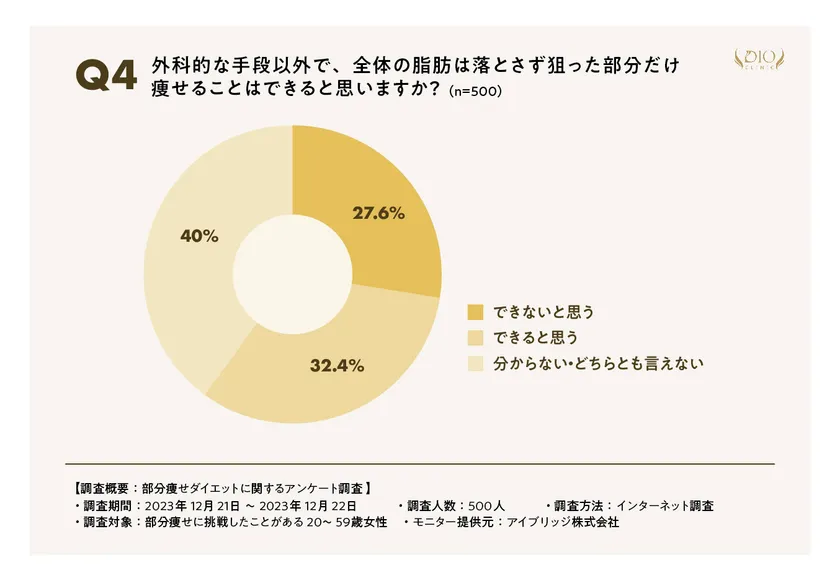
Partial Slimming Questionnaire 04
Although only less than 20% of the respondents succeeded in losing weight in certain areas, the results were contrary to the fact that "I think it is possible (32.4%)" and "I don't know or can't say (40%)" were asked if they think it is possible to lose fat in only certain areas.
Opinion of Dr. Takahiro Fujii, General Director of ▼Dio Clinic
The following is the opinion of Dr. Fujii, General Director of Dio Clinic, regarding the results of the survey on partial weight loss diets.
Is it possible to lose weight in the first place?
In conclusion, it is difficult to lose weight by reducing subcutaneous fat only in the area of concern with ordinary dieting methods. The reasons why it is difficult to lose weight in certain parts of the body are that the areas where fat tends to accumulate differ from person to person, and the way in which fat is lost cannot be controlled by oneself.
In women, subcutaneous fatty obesity, or pear-shaped obesity, is more common, and subcutaneous fat tends to accumulate on the lower body, such as the thighs and buttocks. Subcutaneous fat is found not only on the lower body but also on the upper body, and once it accumulates, it is difficult to reduce even with dieting. On the other hand, visceral fat obesity, or apple-shaped obesity, in which excess fat accumulates around the internal organs of the abdomen, is more common in men. When dieting through diet restriction and exercise, visceral fat is first reduced. However, it may be difficult to realize the effect of partial weight loss just by reducing visceral fat. The key to achieving partial weight loss and achieving an ideal style is to lose subcutaneous fat. As fat is lost, subcutaneous fat is first gradually reduced from the tips of the arms and legs, and the center of the body, including the abdomen, and the sensory area are reduced later. Since exercise and massage cannot directly reduce subcutaneous fat (exercise increases calorie consumption and muscle mass, which indirectly facilitates weight loss, but it is not possible to target only the area of subcutaneous fat to be lost), it can be said that partial weight loss is difficult to achieve with general dieting methods. It can be said that it is difficult to lose weight in a certain part of the body by general dieting methods.
Why do so few people think that it is impossible to lose weight even if they fail to lose weight?
The reason why many people think that it is possible to lose weight even if they fail to lose weight is because they have become familiar with information about partial body slimming through the web media such as SNS, famous people who have succeeded in losing weight and before-and-after case images at clinics, etc. They may subconsciously think that it is possible to lose weight even if they fail. It is possible that they subconsciously believe that they can lose weight in their own body parts.
As I mentioned earlier, it is difficult to lose weight on one's own, but there are fat cooling devices and other slimming medical devices approved by the FDA (U.S. Food and Drug Administration), which have a role similar to that of the Ministry of Health, Labor and Welfare or the U.S. Department of Health, Labor and Welfare. If you want to lose weight, you may want to consult with a medical institution.
About the medical diet at Dio Clinic
We offer a combination of drug therapy, nutritional guidance, mechanical treatment, and fat dissolving injections, and will consult with you on the best weight loss goal and body makeover plan for each individual.
The characteristics of medical dieting are simply that it does not require strict dietary restrictions or hard training.
Thanks to this, our clinic has experienced the largest number of cases in the slimming medical industry. We have accumulated a large amount of data from a large number of cases, and as a medical institution, we naturally maintain a high level of safety and effectiveness.
We hope that you will feel free to visit our clinic and consult with us. Our professionals with a wealth of case experience are waiting for you.
- Category:
- Research & Reports
- Genres:
- Health & Healthcare Beauty Society(Japan)
